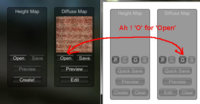I was thinking that objects in Unreal and Unity would be lower poly count than anything we would create/use in Poser, which is why I was wondering if materials created with Materialize could be used in Poser, etc.
I'm addressing this separately because I've encountered a lot of misunderstandings about PBRs.
Quixel, the Substance suite, and other tools have touted PBRs as a revolution in realism, but that's only true for games, which had long required fakes. Most PBR materials, and certainly the Quixel, Allegorithmic, and Toolbag Marmoset ones, are a whole lot less realistic than, for instance, the unbiased Reality/Luxrender and Octane materials that preceeded them. Also, while they used actual lab results (which is so awesome), they focused on the materials important to games: metals, plain glossy materials, and grungy matte materials. They didn't even support refraction to begin with. So we have "metallicity" maps and settings for clear coat on top of already shiny paint, but no maps that account for SSS, anisotropy, or the sigma of velvet.
But that's OK, because metals and non-scattering dielectrics are a big portion of materials. And the big thing all PBR-based shading systems work hard to get right is Fresnel and its relationship to roughness, so you can use a PBR node/shader for both car paint and plaster and have it look great.
Still, if you were already using something unbiased and spectral like Octane, you're probably not seeing any advances in realism. What's useful for you is the standard.
PBRs standardized maps and what they do. Since games are _the_ biggest, broadest, and most consistent market in 3D, the two industry standard game systems are the ones everyone else is judging against. For instance, Blender 2.8 has a real time rendering engine Eevee. Given an object with a set of PBR-based maps, its performance is being compared to Unity.
The PBR standard has done for renderers what HTML/CSS have done for documents: made them portable, quasi-universal, and blessedly consistent.
So while Unity and Unreal are the standard to judge maps against and where most 3D artists intend their maps to render, those maps can be used in every system that supports PBRs. Which is at this point most rendering systems, including Poser and DS, for the same reason browsers support HTML and not some unique hypertext standard.
But even if your renderer doesn't have a built in way to make using PBR standard maps useful, you can still use them. By far most material systems use diffuse/color/albedo, specular, bump/normal, and displacement. But while a good PBR-based system is designed to take maps and approximate the same performance as in Unity or Unreal given the same maps/values, you will probably have to adjust how your control maps work in a non-PBR system. For instance, one of the _big_ things that Blender's Physical node did was handle the complex math involved in handling Fresnel and reflection properly from low to with high roughness/glossiness. Lots of people made their own PBR UberShader compound nodes before it came out, but none of them handled that math as well.
PBR maps are pretty much universally useful, because all maps are pretty much universally useful. But it's probably worth it to use whatever tools your renderer has supporting PBR shaders, because it's just so very much easier and more consistent with other people's work.

 ) if software needs a tutorial it's badly designed.
) if software needs a tutorial it's badly designed. 